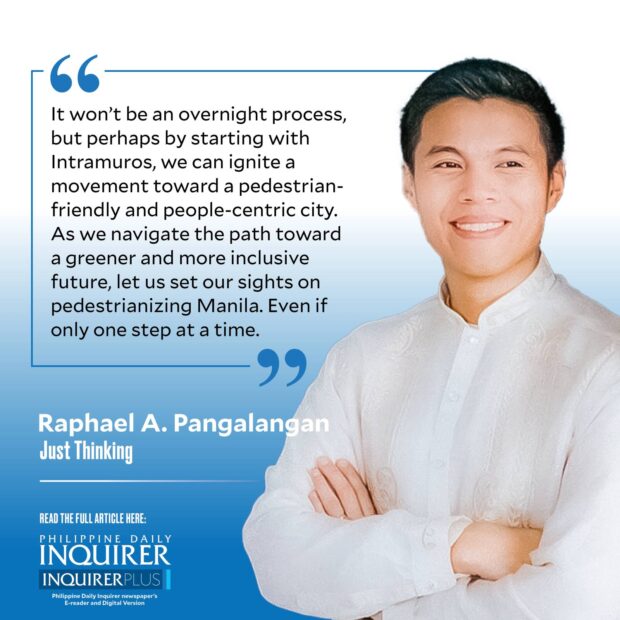Pedestrianize Manila
Metro Manila is an “about an hour” kind of city. Whether you’re on your way to school or heading home from work, it’ll take about an hour to get there. Any more would still be par for the course. Any less would be sufficient reason to sing praises to the heavens.
In the yesteryears, I grew up to stories about spontaneous trips to the breakwater of Manila Bay. Today, any trip to and through the capital has become much more calculated. Gone are the days of the sudden romantic getaway. In 2023, we’ve traded in spontaneity for strategy.
Article continues after this advertisementIn a previous piece, I had already written on how Metro Manila’s traffic steals more than just minutes. There, I suggested that one way we could decongest traffic is by developing walker and biker-friendly pathways. Let’s probe into this further.
Alas, Manila is not renowned for its pedestrian-friendly infrastructure. Indeed, a quick Google search reveals that—perhaps unwittingly—we conceive pedestrianization only in terms of “pockets,” “spots,” and “corridors.” Our words of choice highlight that pedestrian paths are exceptions rather than the rule. It paints a clear picture where sidewalks are surgically gerrymandered from roads where it is not man, but motor that reigns supreme.
We need to find a solution. Thus, cue in the 15-minute city.
Article continues after this advertisementThe concept of the 15-minute city has been gaining traction to address this issue of congestion and promote sustainable urban living. This model envisions a city where everything essential for a person’s daily life—work, schools, shops, parks, and cultural activities—is within a 15-minute walk or ride from their home.
The 15-minute city is not a distant dream; it has already been explored in various places around the world. In countries like the Netherlands, the 15-minute city is a reality. For instance, the nearest Albert Heijn grocery store is just a 15-minute bike ride away from residential areas. Longer trips, such as those to the university, require a longer time investment, that is, a 15-minute bus ride. This demonstrates how daily activities can be seamlessly integrated within a short distance from one’s residence—by foot, bike, or by bus.
Granted, pedestrianizing Manila will not happen overnight. But if we were to take the first step, I would begin with Intramuros. This historic walled city, once the seat of power during Spanish colonial rule, is now a living heritage site within the bustling city. While its historical significance draws tourists and locals alike, its current state leaves much to be desired. The cobblestone streets, remnants of the past, now share space with motor vehicles, dampening the immersive experience of stepping back in time. Traffic congestion and pollution tarnish the charm of this cultural treasure.
Intramuros stands as a testament to the Philippines’ colonial past, for better or for worse. But what’s for sure, its transformation into, and in a way its perseveration as, a pedestrian-friendly area could serve as a beacon of change for the rest of Metro Manila.
Moreover, pedestrianizing Intramuros aligns with the city’s efforts to promote sustainable tourism and heritage conservation. By reducing vehicular traffic within the walls, we can reduce air pollution and environmental degradation, allowing Intramuros to be a model for a greener and more sustainable future. Tourism would undoubtedly flourish as visitors from near and far would be enticed to experience the charm of a car-free Intramuros. The economic impact on local businesses and artisans would be significant, fostering cultural appreciation and preservation.
However, pedestrianizing Intramuros is only a stepping stone toward a broader transformation of the city. To achieve a more accessible and livable city, we must also decentralize Manila. (More on this on another occasion!) Embedding pedestrian-friendly infrastructure and adopting the 15-minute city model in the early stages of urban development can pave the way for a more inclusive and resilient metropolitan area.
It won’t be an overnight process, but perhaps by starting with Intramuros, we can ignite a movement toward a pedestrian-friendly and people-centric city. As we navigate the path toward a greener and more inclusive future, let us set our sights on pedestrianizing Manila. Even if only one step at a time.
—————-
thinkjustly@gmail.com

















